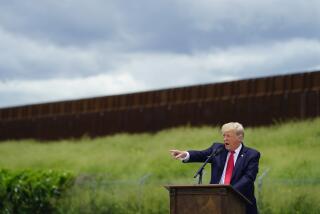No Longer on the Back Burner : Frequent-flier Bush completes vital Latin trip
- Share via
As President Bush completes the latest of his foreign trips, a week-long swing through five South American nations, questions are being raised in this country about whether it was wise or even useful.
Correspondents who cover the White House have begun reporting that constant travel seems to be taking a physical toll on the 66-year-old Bush. The last couple of months-- with the Persian Gulf crisis as the constant backdrop to everything Bush does--have been especially punishing.
Certainly the case can be made that with an unpredictable crisis playing itself out--especially one that could put the United States in its biggest shooting war in a generation--the President should wander no further from the Oval Office than the Rose Garden. But, in fairness, the White House staff can make a good argument that each of Bush’s recent sojourns served a valid purpose.
His November trip to Europe allowed Bush to join other world leaders at the signing of security agreements that marked the end of the Cold War, certainly an historic event. And who can question the value of pressing the flesh and showing support to American soldiers in the field, as he did on Thanksgiving Day. And Mexico, while usually ignored by most U.S. citizens, is not just a recurring foreign policy issue but--with the Soviet Union self-absorbed--now arguably our most important foreign policy challenge.
Which leaves only the trip to South America to be questioned. And, let’s face it, Latin America, in general, has never been a priority for most folks in Washington, be they pundits, politicians or other policy-makers. So what’s really being asked, we suspect, is whether five days in Brazil, Uruguay, Argentina, Chile and Venezuela were worth the trouble.
Yes they were. Except for Chile, the nations visited by Bush are not as far along as Mexico in moving toward the open economies and free-trade policies that Bush and Secretary of State James A. Baker III so ardently believe in--but they are heading in that direction. Anything this country can do to help them along is a matter of enlightened self-interest. At least in the short term, the world seems to be realigning itself into trading blocs, with Europe and East Asia poised to further challenge the United States for economic supremacy in the 1990s. If that happens, our neighbors in the Western Hemisphere may just prove our most reliable and eager trading partners.
That is why it’s vital for Washington to show Latin America that it is important, even if the message is largely symbolic for now. Symbolism counts for a lot in diplomacy. And, for all the gringo-bashing that goes on south of the border, the United States counts for a lot in Latin America. Most Argentines can tell you that the last American President to visit their nation was Dwight Eisenhower in 1958. How many of us remember that? We’re willing to bet that Latin Americans will remember Bush’s trip, too, long after this country has forgotten it. That’ll be good for the United States--and to the President’s credit.
More to Read
Sign up for Essential California
The most important California stories and recommendations in your inbox every morning.
You may occasionally receive promotional content from the Los Angeles Times.










